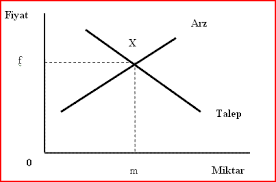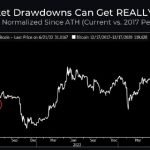The law of supply and demand is a theory that explains the interaction between sellers of a resource and buyers of that resource. The theory describes the relationship between the price of a particular good or product and people’s willingness to buy or sell it. Generally, as the price goes up, people are willing to supply more and demand less, and vice versa when the price goes down.
What is the Law of Supply and Demand?
The theory is based on two separate “laws”, the law of demand and the law of supply. The two laws interact to determine the true market price and the volume of goods on the market.
The law of demand says that at higher prices, buyers will demand less economic goods. The law of supply says that sellers will supply more affordable goods at higher prices. These two laws interact to determine actual market prices and the volume of goods traded in a market. Several independent factors that affect the prices and quantities we observe in the markets can influence the pattern of market supply and demand.
The law of supply and demand, one of the most fundamental economic laws, is somehow connected to almost all economic principles. In practice, people’s willingness to supply and demand a good determines the market equilibrium price, or price at which the amount of the good people are willing to supply equals the amount people demand.
However, multiple factors can affect both supply and demand, causing them to increase or decrease in various ways.
Sue
The law of demand states that, all other factors being equal, the higher the price of a good, the fewer people will demand that good. In other words, the higher the price, the lower the quantity demanded. Buyers buy less of a good at a higher price because the higher the price of a good, the higher the opportunity cost of that good.
As a result, people will naturally avoid buying a product that will force them to stop consuming something they value more.
Like the law of demand, the law of supply indicates quantities sold at a given price. However, unlike the law of demand, the supply relationship shows an upward slope. This means that the higher the price, the higher the quantity supplied. From the seller’s perspective, the opportunity cost of each additional unit tends to be higher and higher. Manufacturers supply more at a higher price because the higher selling price justifies the higher opportunity cost of each additional unit sold.
Understanding that time is always a dimension in these charts is important for both supply and demand. The quantity demanded or supplied on the horizontal axis is always measured in units of the good in a given time period. Longer or shorter time intervals can affect the shapes of both the supply and demand curves.
Supply and Demand Curves
At any given time, the supply of a good is fixed. In other words, while the supply curve is a vertical line in this case, the demand curve is always downward sloping due to the law of diminishing marginal utility. Sellers cannot demand more than the market can carry based on current consumer demand.
However, over longer periods of time, suppliers may increase or decrease the quantity they supply, depending on the price they expect to charge. Thus, over time, the supply curve slopes upward; The more suppliers charge, the more they will be willing to produce and bring to market.
For all periods, the demand curve slopes downward due to the law of diminishing marginal utility. The first unit of a good requested by any buyer will always be used for that buyer’s most valuable use. For each additional unit, the buyer will use (or plan to use) it for a successively lower value use.

Shifts and Movement
For economics, “moves” and “shifts” in supply and demand curves represent very different market phenomena.
A movement refers to a change along a curve. In the demand curve, a movement refers to a change in price and quantity demanded from one point on the curve to another. The move implies that the demand relationship remains consistent. Therefore, a movement along the demand curve will occur when the price of the good changes and the quantity demanded changes relative to the original demand relationship. In other words, a movement occurs when a change in quantity demanded is caused only by a change in price and vice versa.
Like a movement along the demand curve, the supply curve means that the supply relationship remains consistent. Therefore, a movement along the supply curve will occur when the price of the good changes and the quantity supplied changes by the original supply relationship. In other words, a movement occurs when a change in quantity supplied is caused only by a change in price and vice versa.
shifts
Meanwhile, a shift in the demand or supply curve occurs when the quantity demanded or supplied of a good changes even if its price remains the same. For example, if the price of a bottle of milk was $2 and the quantity of milk demanded increased from Q1 to Q2, there would be a shift in beer demand. Shifts in the demand curve mean that the original demand relationship changes, i.e. demand for quantity is affected by some factor other than price.
Conversely, if the price of a bottle of milk were $2 and the quantity supplied fell from Q1 to Q2, there would be a shift in the supply of milk. Like a shift in the demand curve, a shift in the supply curve means that the original supply curve has changed; this means that the quantity supplied is affected by a factor other than price.
equilibrium price
The equilibrium price, also called the market clearing price, is the price at which the producer can sell all the units he wants to produce and the buyer can buy all the units he wants.
With an upward-sloping supply curve and a downward-sloping demand curve, it is easy to visualize that the two will intersect at some point. At this point, the market price is sufficient to induce suppliers to put on the market the same quantity of goods that consumers are willing to pay at that price. Supply and demand are balanced or in balance. The exact price and quantity where this happens depends on the shape and location of the respective supply and demand curves, each of which can be influenced by a variety of factors.
Factors Affecting Supply
Supply is largely a function of production costs, including:
- Labor and materials (reflecting the opportunity costs of alternative uses to provide other goods to consumers)
- Existing physical technology to combine inputs
- Number of vendors and their total productive capacity in a given time period
- Taxes, regulations or additional corporate production costs
Factors Affecting Demand
Consumer preferences among different goods are the most important determinants of demand. The presence and prices of other consumer goods that are substitutes or complementary products can change demand. Changes in conditions that affect consumer choices, such as seasonal changes or the effects of advertising, can also be significant. Changes in revenues can also be significant in increasing or decreasing the quantity demanded at any price.
What is a Brief Explanation of the Law of Supply and Demand?
In essence, the Law of Supply and Demand describes a phenomenon that we are all familiar with from our daily lives. All else being equal, it describes how the price of a good tends to increase when the supply of a good decreases (making it rarer) or when demand for that good increases (making more sought after for the good). Conversely, it describes how the price of goods will fall as they become more common (less rare) or less popular among consumers. This fundamental concept plays a vital role throughout the modern economy.
Why is the Law of Supply and Demand Important?
The Law of Supply and Demand is essential because it helps investors, entrepreneurs, and economists understand and predict market conditions. For example, a company launching a new product may deliberately try to raise the price of its product by increasing consumer demand through advertising.
At the same time, they may try to increase their prices further by deliberately restricting the number of units they sell to reduce supply. In this scenario, demand will be maximized while supply will be minimized, resulting in a higher price.
What Is an Example of the Law of Supply and Demand?
To illustrate, let’s continue with the above example of a company looking to market a new product at the highest possible price. Presumably, in order to achieve the highest profit margin, the same company will want to ensure that its production costs are as low as possible.
To do this, he can get bids from multiple suppliers and ask each supplier to compete with each other to provide the lowest possible price to manufacture the new product. In this scenario, producers’ supply is increased to reduce the cost (or “price”) of manufacturing the product.





